INGROWN TOENAIL
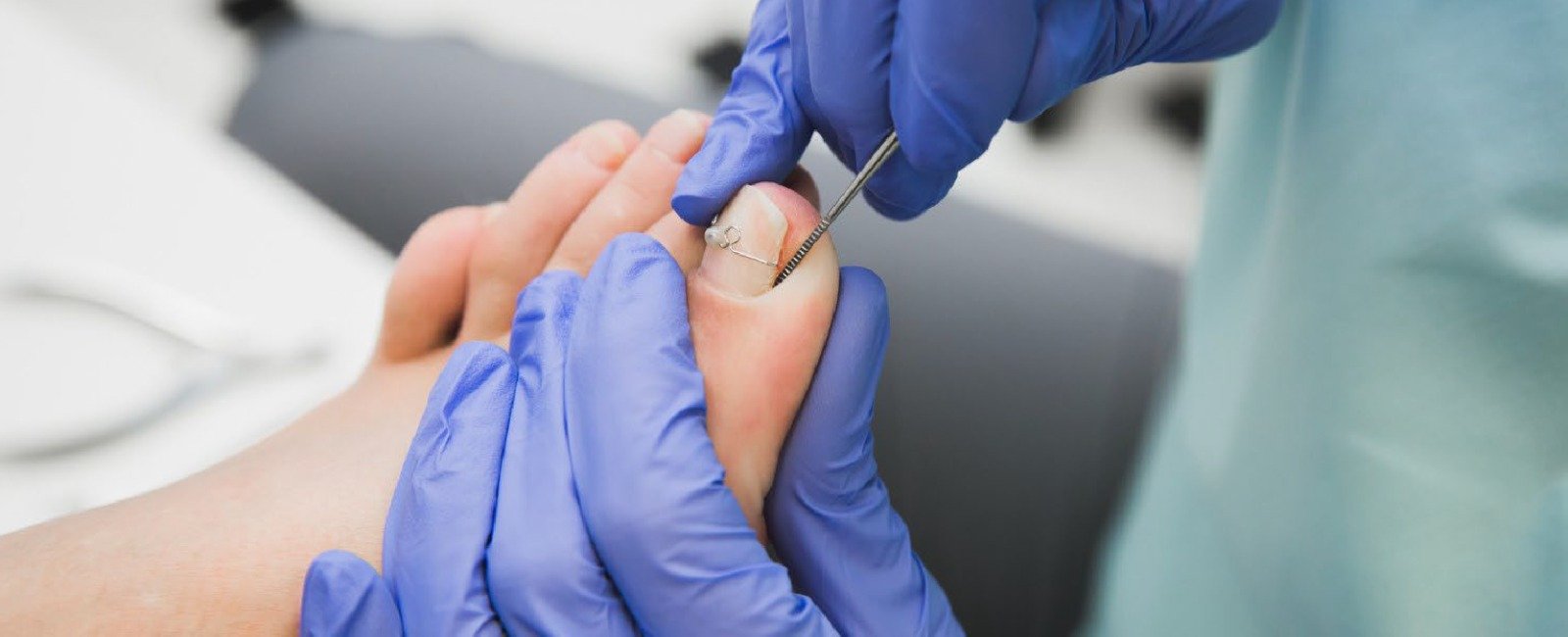
Step into Comfort with Expert
Solutions for Ingrown Toenails
Step into Comfort with Expert Solutions for Ingrown Toenails
INGROWN TOENAIL
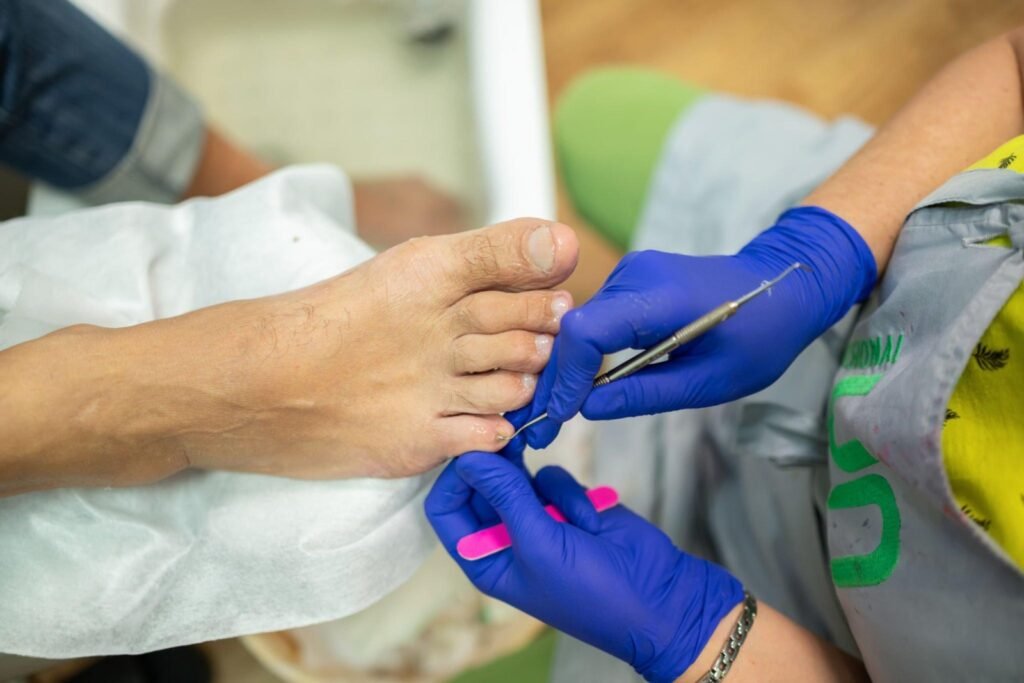
WHAT ARE INGROWN TOENAILS?
WHAT ARE THE SYMPTOMS OF INGROWN TOENAILS?
The symptoms of ingrown toenails can range from mild discomfort to more severe pain and signs of infection.
Here are common symptoms associated with ingrown toenails:
- Pain and Tenderness:
Tenderness and soreness on the side of the toenail are among the first signs. Pressing on the injured toe could make it more uncomfortable. - Redness and Swelling:
The surrounding skin near the ingrown toenail often becomes red and swollen. This inflammation is a result of the nail digging into the adjacent skin. - Warmth to the Touch: The affected area may feel warm to the touch due to the inflammatory response. Increased blood flow to the area contributes to the sensation of warmth.
- Difficulty Wearing Shoes:
As the toenail grows into the skin, wearing shoes, especially those that are tight or narrow, can become uncomfortable and exacerbate the symptoms. - Formation of a Pus-filled Bump:
In more severe situations, the ingrown toenail location may form an abscess or pus-filled lump. This indicates that an infection is present and has to be treated right away. - Bleeding: Ingrown toenails may cause minor bleeding, particularly if the nail has penetrated the skin. This can result in small amounts of blood visible around the affected area.
- Infection Signs: Signs of infection include increased pain, persistent redness, swelling, and the presence of pus or drainage. If infection sets in, seeking medical attention is crucial to prevent complications.
- Overgrowth of Skin: As a response, the skin around the affected area may overgrow, forming a fleshy mass known as hypergranulation tissue. It's crucial to remember that symptoms might vary in intensity. People who have diabetes or circulatory problems should be especially watchful as they may be more susceptible to consequences. It is essential to consult a podiatrist or other healthcare provider if you notice worsening or chronic symptoms. Early ingrown toenail treatment may reduce discomfort and stop the illness from getting worse.
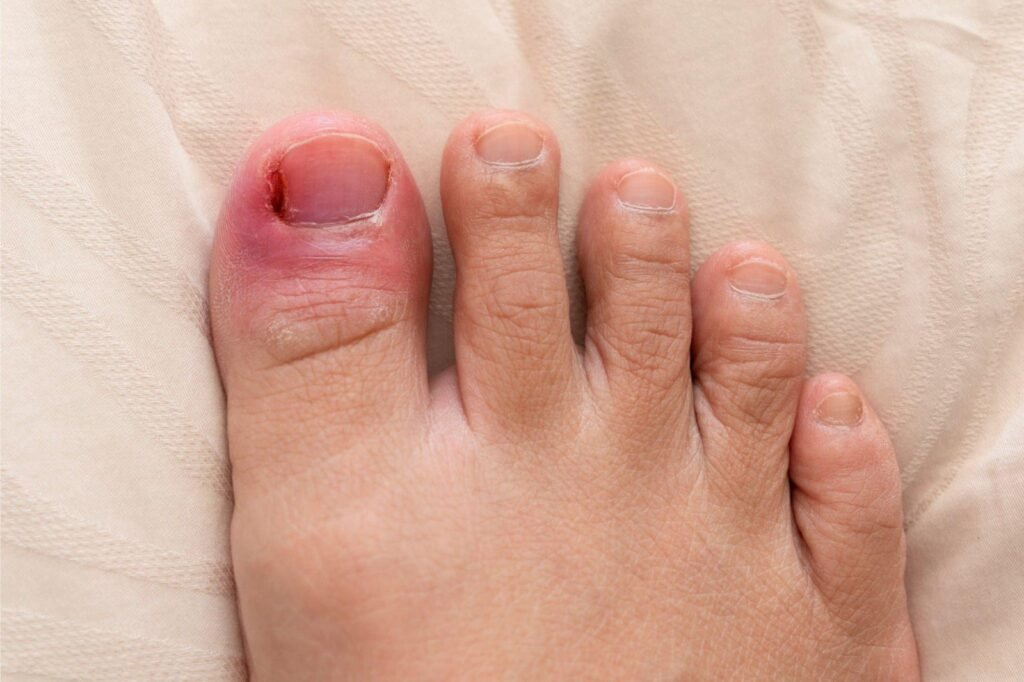
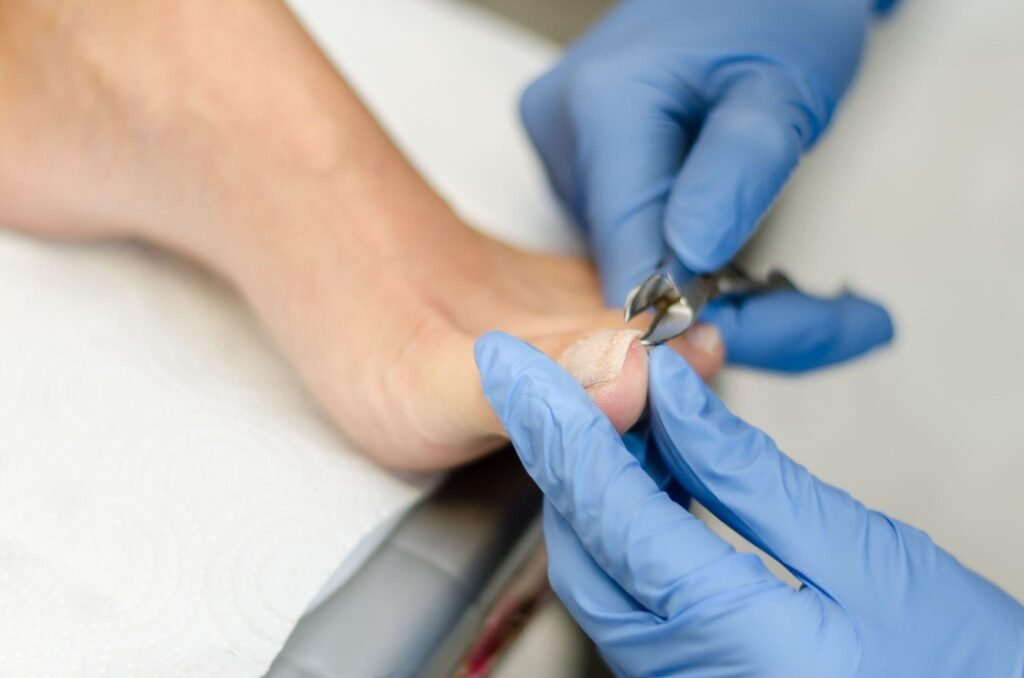
WHAT ARE THE RISK FACTORS FOR IN- GROWN TOENAILS?
Several factors contribute to the development of ingrown toenails. Understanding these risk factors can help individuals take preventive measures and address potential causes.
Common risk factors include:
- Improper Nail Trimming:
Cutting toenails too short or rounding the edges instead of trimming straight across can encourage the toenail to grow into the surrounding skin. - Tight or Ill-Fitting Shoes:
Wearing shoes that are too tight or narrow can exert pressure on the toes, pushing the toenails into the skin. - Toe Injuries:
Trauma or injury to the toe, such as stubbing the toe or dropping a heavy object on it, can lead to ingrown toenails. - Genetic Predisposition:
Some individuals may have a genetic predisposition to developing ingrown toenails. If family members have a history of ingrown toenails, there may be an increased risk. - Abnormal Nail Shape:
Certain nail shapes, such as involuted or curved nails, may be more prone to becoming ingrown. - Excessive Sweating:
Excessive sweating can soften the skin around the toenails, making it easier for the nails to penetrate the skin. - Poor Foot Hygiene:
Ingrown toenails can occur as a result of poor foot care, such as failing to keep the feet dry and clean. - Underlying Conditions:
Certain underlying conditions, such as fungal infections or nail diseases, may increase the risk. - Toe Deformities:
Structural abnormalities or deformities of the toes may create an environment conducive to ingrown toenails. - Incorrect Footwear Choices:
Wearing high heels or shoes with a pointed toe box can contribute to the development by putting pressure on the toes. - Age: Adolescents and young adults are more prone to ingrown toenails, possibly due to growth spurts or changes in foot structure.
- Poor Nail Cutting Technique: Cutting nails at an angle or using improper tools for nail trimming can increase the risk of it.
Understanding these risk factors allows individuals to adopt preventive measures, such as wearing properly fitting shoes, practicing good foot hygiene, and using correct nail trimming techniques. In cases where ingrown toenails persist or lead to complications, seeking advice from a healthcare professional or podiatrist is advisable for appropriate ingrown toenail treatment and care.
HOW DOES MY PODIATRIST DIAGNOSE INGROWN TOENAILS?
A podiatrist will usually perform a comprehensive examination in order to diagnose ingrown toenails.
The following steps are part of the diagnostic process:
- Clinical Examination: The podiatrist will conduct a visual examination of the affected toe, looking for signs like redness, swelling, tenderness, and any visible signs of an ingrown toenail.
- Patient History: Obtaining details regarding the patient's medical background, such as prior incidents of ingrown toenails, recent injuries, or underlying medical disorders that might be a factor in the problem.
- Physical Assessment: The podiatrist will evaluate the surrounding skin and ingrown toenail structure. They might look for anomalies in the nails, like curved or uneven growth patterns.
- Pain Assessment: The location and intensity of the pain are taken into account, as well as the patient's description of their discomfort.
- Testing for Infection: The podiatrist may do tests to ascertain the degree of the illness and establish the best course of therapy if there are indications of infection, such as pus or drainage.
- Assessment of Underlying Causes: Identifying and addressing underlying causes, such as improper footwear, nail care practices, or genetic predispositions, is an important part of the diagnostic process.
- Discussion of Symptoms: The podiatrist will talk about the patient's symptoms, such as when the pain started, any triggers, and things that could make it worse or better.
- Digital Pressure Test: Applying gentle digital pressure to the sides of the toenail to assess pain and tenderness, helping to pinpoint the location of the ingrown nail.
- Observation of Nail Growth: Observing the direction of nail growth and assessing if any sharp edges or spicules are digging into the surrounding skin. Based on the findings from these assessments, the podiatrist can make a definitive diagnosis of an ingrown toenail and determine the appropriate course of treatment. Ingrown toenail treatment options may include conservative measures such as proper nail trimming, warm soaks, and topical antibiotics for mild cases. In more severe or recurrent cases, minor surgical procedures may be considered to ingrown toenail removal. The podiatrist will tailor the treatment plan to the individual patient's needs and the severity of the ingrown toenail.

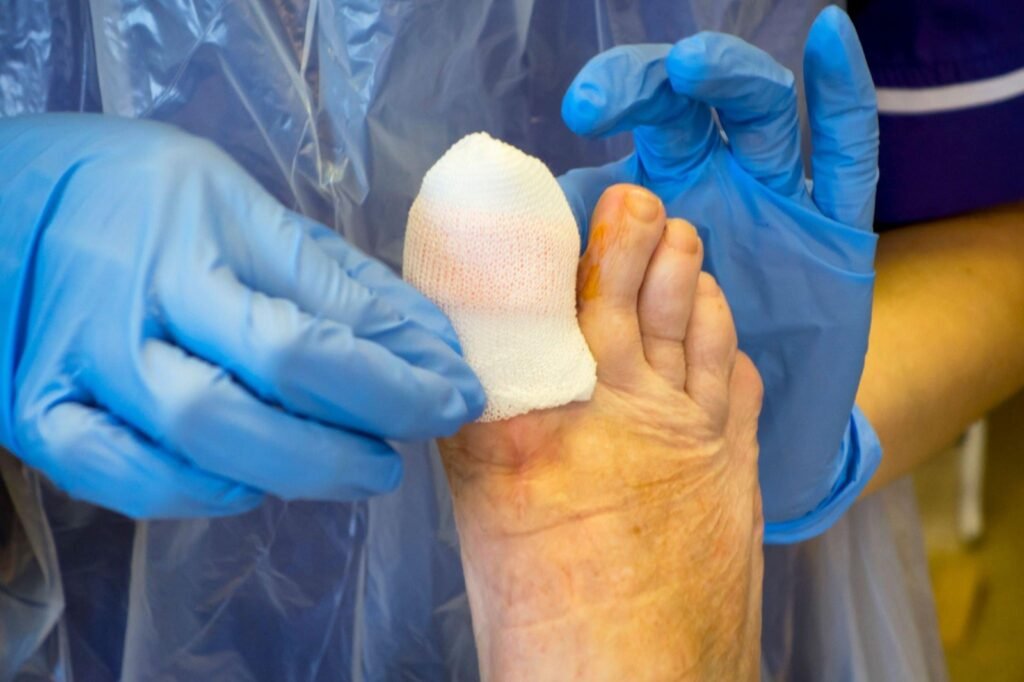
HOW ARE INGROWN TOENAILS TREATED?
The ingrown toenail treatment depends on the severity of the condition.
Here are common approaches to managing ingrown toenails:
- Conservative Measures: Conservative approaches might work well in mild situations. This entails submerging the foot in warm water containing Epsom salts, gently removing the ingrown nail edge, and stimulating healthy nail development beneath the nail with a tiny piece of cotton or dental floss.
- Proper Nail Trimming: Educating the patient on proper nail trimming techniques is essential. Trimming the toenails straight across and avoiding rounded edges can prevent ingrown toenails from recurring.
- Foot Soaks: Soaking the affected foot in warm water can help reduce inflammation and soften the skin, making it easier to manipulate the ingrown toenail gently.
- Topical Antibiotics: Applying topical antibiotics can help prevent infection if there are signs of inflammation or minor cuts around the ingrown toenail.
- Wearing Comfortable Footwear: Wearing shoes that provide adequate room for the toes and avoiding tight or ill-fitting footwear can alleviate pressure on the toenail.
- Avoiding Aggravating Factors: Patients are advised to avoid activities that may worsen the ingrown toenail, such as wearing tight shoes, engaging in activities that cause repetitive pressure on the toes, or attempting to trim the toenail at home without proper guidance.
- Professional Nail Trimming: In some cases, a podiatrist may perform professional nail trimming to safely and effectively address the ingrown toenail.
- Surgical Intervention: If conservative measures are ineffective or if the ingrown toenail is recurrent and causing significant pain, a podiatrist may recommend a minor surgical procedure. This may involve partial nail avulsion, where a portion of the ingrown nail is removed while preserving the healthy part.
- Matrixectomy: A podiatrist may conduct a matrixectomy, which entails removing a piece of the nail matrix to prevent the ingrown nail from growing back, in cases of persistent or recurrent ingrown toenails.
- Oral Antibiotics (if infected): If an ingrown toenail is infected, oral antibiotics may be prescribed to manage the infection.
It's critical that people with ingrown toenails get medical attention, particularly if there are symptoms of infection, severe pain, or persistent problems. Without the right supervision, self-treating ingrown toenail treatment at home can get complicated. Our podiatrists have the skills to diagnose conditions, treat patients appropriately, and provide preventative care to lower the likelihood of recurrence.
Ingrown Toenails



